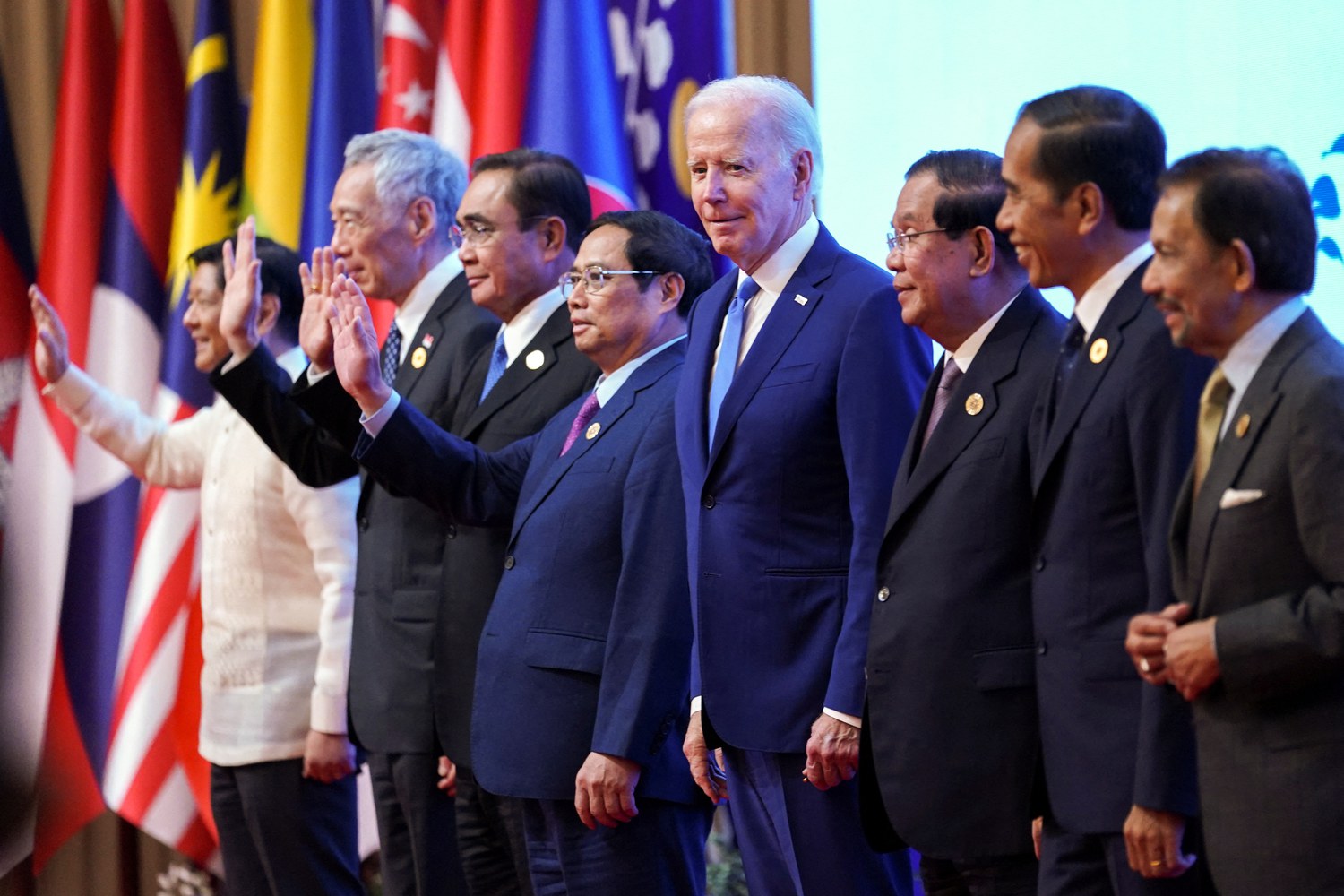China
Biden steps up engagement with ASEAN amid China rivalry and global conflict
Cambodia is hosting the summit as it holds the rotating chairmanship of the 10-nation ASEAN bloc. Indonesia takes the chair after this week’s summits.

U.S. President Joe Biden offered rare praise for Cambodia’s authoritarian premier as he encouraged diplomatic support for ending the war in Ukraine and bringing peace to Myanmar at a summit with Southeast Asian leaders on Saturday.
Although the control of U.S. Congress lies in the balance back in Washington, Biden signaled commitment to the region by attending an annual gathering of leaders of the Association of Southeast Asian Nations.
His appearance in Phnom Penh, a day after attending a climate change conference in Egypt, serves as a prelude to the first face-to-face meeting of his presidency with Chinese leader Xi Jinping, which will take place in Bali, Indonesia, on Monday. The U.S. and China vie for influence in Southeast Asia.
Although Cambodia has faced some stiff criticism from the U.S. over its suppression of democracy, Prime Minister Hun Sen welcomed the president saying the meeting showed the Biden administration’s commitment to “ASEAN centrality and a rule-based regional architecture to maintain peace and stability in the region.”
“We support the engagement of the U.S in our ASEAN community building process as truly important, especially in the context of bolstering ASEAN’s recovery from the COVID-19 crisis, promoting regional resilience as well as addressing many pressing issues such as climate change, food and energy security,”
U.S. President Joe Biden
he said, adding that ASEAN planned to extend relations with the U.S. to a comprehensive strategic partnership. That will put the U.S. on level-pegging with China, which already has that status.
Cambodia is hosting the summit as it holds the rotating chairmanship of the 10-nation ASEAN bloc. Indonesia takes the chair after this week’s summits.
Biden stressed the importance of the partnership, saying the U.S administration would build on the past year’s U.S. $250 million in new initiatives with ASEAN by requesting a further $850 million for the next 12 months. He said it would pay for more Southeast Asian projects such as an integrated electric vehicle ecosystem and clean energy infrastructure to reduce carbon emissions.
“Together we will tackle the biggest issues of our time from climate to health security, defend against significant threats to rule-based order, and to threats to the rule of law, and to build an Indo-Pacific that’s free and open, stable and prosperous, resilient and secure,” Biden said.
The linchpin of the U.S. push in Southeast Asia is the Indo-Pacific Economic Partnership (IPEF) that is intended to intensify America’s economic engagement in the region. ASEAN is America’s fourth-largest trading partner.
Whether the members of ASEAN will be impressed by what the U.S. has to offer is another matter.
“I don’t think ASEAN states are much sold on IPEF. It contains parts that are anathema to them and yet isn’t really a trade deal, and does little to actually further regional economic integration. It’s a fairly weak package overall,” said Joshua Kurlantzick, senior fellow for Southeast Asia at the Council on Foreign Relations.
“China is already by far the region’s dominant economy and trade partner and the U.S. isn’t going to materially change that. Southeast Asian states are stuck with China as their dominant economic partner.
“For some Southeast Asian states [there is] a desire to build closer strategic ties with the U.S, but the U.S. is not going to now replace China as the region’s dominant trade partner.”
CREDIT: Reuters/Kevin Lamarque
In a comment that would have raised some eyebrows among critics of the Cambodian government’s human rights record, Biden on Saturday thanked Hun Sen – for critical remarks about the war in Ukraine and for co-sponsoring U.N resolutions.
Earlier this week, Hun Sen met with the Ukrainian foreign minister. He’s also expressed concern about recent attacks on Ukrainian cities and civilian casualties.
Russian President Vladimir Putin has skipped the ASEAN summit and sent Foreign Minister Sergei Lavrov in his place.
However, Biden did call for transparency over Chinese military activities at Ream Naval base on Cambodia’s southern coast, and urged Hun Sen “to reopen civic and political space ahead of 2023 elections,” and release Theary Seng, an imprisoned U.S.-Cambodian lawyer and activist.
The other conflict that Biden mentioned in his public comments to ASEAN leaders was Myanmar, whose military leader was not invited to the summit. Biden said he looked forward to the return of democracy there.
Human rights groups have assailed the Southeast Asian bloc for its failure to put more pressure on Myanmar to end the civil war that followed a February 2021 military coup against an elected government.
On Friday, ASEAN leaders took a marginally tougher stand, calling for measurable progress toward the goals of its Five Point Consensus that include restoring democracy and delivering humanitarian aid.
On Saturday Antonio Guterres voiced his support for the plan, saying “the systematic violation of human rights are absolutely unacceptable and causing enormous suffering to the Myanmarese people.”
Cambodia, which has jailed opposition politicians and environmentalists, was not spared criticism by the U.N. secretary general.
“My appeal in a country like Cambodia is for the public space to be open and for human rights defenders and climate activists to be protected,” he said.
Biden attends the East Asia Summit on Sunday, also hosted by Cambodia, where he plans once again to discuss ways to end the Russian invasion of Ukraine and limit the global impact of the war in terms of fuel and grain shortages that are fueling global inflation.
The U.S. president is also holding talks with Japanese Prime Minister Fumio Kishida and South Korean President Yoon Suk-yeol expected to focus on North Korea’s recent barrage of missiles fired into the seas off the Korean peninsula — including one that passed over Japan. North Korea is also reported to be planning a nuclear test.
Biden then heads to the Indonesian island of Bali to attend the Group of 20 leaders’ summit.
Ahead of the G20, on Monday Biden will meet with China’s leader Xi. It will be their first face-to-face talks since Biden took office nearly two years ago.
Biden will tell Xi that if North Korea…
Read the rest of this article here >>> Biden steps up engagement with ASEAN amid China rivalry and global conflict
China
China’s November 2024 Economy: Navigating Mixed Signals and Ongoing Challenges

In November 2024, China’s economy exhibited mixed results: industrial production rose by 5.4%, while retail sales grew only 3%, below forecasts. Fixed asset investment also faltered. Policymakers are anticipated to introduce measures to stimulate domestic demand and combat deflation.
China’s economy showed mixed performance in November 2024, with industrial production and exports showing resilience, while retail sales and fixed asset investment underperformed, amid ongoing challenges in the property sector. Policymakers are expected to implement targeted fiscal and monetary measures to boost domestic demand and address deflationary pressures.
The National Bureau of Statistics (NBS) has released China’s economy data for November 2024, revealing a mixed performance across key indicators. Retail sales grew by 3 percent year-on-year, a significant slowdown from October’s 4.8 percent growth and well below the 4.6 percent forecast. Industrial production, however, showed resilience, rising by 5.4 percent and exceeding expectations of 5.3 percent growth.
The property sector continued to drag on the broader economy, with real estate investment contracting by 10.4 percent for the January-to-November period, further highlighting the challenges in stabilizing the sector. Fixed asset investment also fell short of expectations, growing by 3.3 percent year-to-date, down from 3.4 percent in October.
In November, China’s industrial value added (IVA) grew by 5.4 percent year-on-year (YoY), slightly accelerating from the 5.3 percent recorded in October. This modest improvement reflects continued recovery in key industries, supported by recent stimulus measures aimed at stabilizing the economy.
The manufacturing sector led the growth, expanding by 6.0 percent YoY, while the power, heat, gas, and water production and supply sector grew by 1.6 percent. The mining industry posted a 4.2 percent YoY increase. Notably, advanced industries outpaced overall growth, with equipment manufacturing and high-tech manufacturing rising by 7.6 percent and 7.8 percent YoY, respectively, underscoring the resilience of China’s innovation-driven sectors.
Key product categories showed robust output gains in November:
From January to November, IVA increased by 5.8 percent YoY, maintaining steady growth over the year despite headwinds from a slowing property market and external uncertainties.
| This article was first published by China Briefing , which is produced by Dezan Shira & Associates. The firm assists foreign investors throughout Asia from offices across the world, including in in China, Hong Kong, Vietnam, Singapore, and India . Readers may write to info@dezshira.com for more support. |
Read the rest of the original article.
China
Ukraine war: 10% of Chinese people are willing to boycott Russian goods over invasion – new study

Since Russia’s 2022 invasion of Ukraine, some Chinese citizens express dissent through potential boycotts of Russian goods, reflecting a complex relationship despite government support for Russia.
Since Russia invaded Ukraine in 2022, the Chinese government has been criticised for its refusal to condemn the war. In 2024, the economic and diplomatic relationship between the two nations appears stronger than ever.
Because of strict censorship and repression imposed by the Chinese Communist Party (CCP), it is difficult to know the extent to which the general public shares their government’s support of Putin’s regime. But a newly published study I carried out with colleagues found that more than 10% of Chinese people surveyed were willing to boycott Russian goods over the war in Ukraine.
This is a surprisingly large figure, especially since existing surveys indicate that Chinese people hold a broadly positive view of their neighbour. We used a representative sample of 3,029 Chinese citizens for this research, to dig into public attitudes to Russia. The survey was done in 2022 after the Ukraine invasion.
We were aware that due to widespread censorship, our participants might not be willing to give honest answers to questions about Russia’s actions in Ukraine. They might also not feel safe to do that in a regime where disagreement with the CCP’s position is often met with harsh punishment. This is why we asked them to tell us if they would be willing to boycott Russian products currently sold in China.
We felt this question was a good indicator of how much the participants disapproved of Russian foreign policy in Ukraine. More importantly, we were also curious to find out whether Chinese citizens would be willing to take direct political action to punish Russia economically for its aggressive behaviour.
In our study, we split respondents into the three different ideological groups in China: “liberals”, who support the free market and oppose authoritarianism; “the new left”, who sympathise with the policies pursued in China under Mao Zedong; and “neo-authoritarians”, who believe the Russian-Ukrainian conflict is an extension of the rivalry between authoritarian China and the liberal United States. These groups were based on the main political beliefs in China.
We found that liberals were most likely to say they were willing to boycott Russian products. Liberals believe that China should work with, rather than against, western democracies. They also place a high value on human rights and democratic freedoms. Because of their beliefs, they are likely to think that Russia’s actions against Ukraine were unprovoked, aggressive and disproportional.
Chinese and Russian economic and diplomatic relations seem closer than ever in 2024.
American Photo Archive/Alamy
The new left and neo-authoritarians we surveyed were more supportive of Russian products. The new left see Russia as a close ally and believe that Nato’s expansion in eastern Europe was a form of aggression. Neo-authoritarians, on the other hand, believe that supporting Russia, an allied autocracy, is in China’s best interest.
Boycotting Russian goods
Asking Chinese participants if they are willing to boycott Russian products might seem like a simple matter of consumer preferences. However, our study reveals a great deal about the way in which regular citizens can express controversial political beliefs in a repressive authoritarian regime.
Boycotting products of certain companies has long been studied in the west as a form of unconventional political action that helps people express their beliefs. However, in the west, boycotting certain products is simply one of many ways people are able to take political action. In a country such as China, boycotting a Russian product might often be the only safe way to express disagreement with the country’s actions.
This is because citizens do not have to tell others they chose not to buy a product, and their actions are unlikely to attract the attention of the authorities.
Since Russian goods are readily available to Chinese consumers and China is encouraging more Russian exports to reach its market, the Russian economy could be significantly affected by an organised boycott campaign in China. The considerable level of support for a boycott expressed by some of our participants, as well as previous acts of solidarity with Ukraine in China, suggest that such a campaign could already be taking place in the country.
This could harm Russia because it regularly exports a number of different products such as meat, chocolate, tea and wine to China. These goods made up 5.1% of China’s total imports in 2023 – and this figure is likely to increase if Russia becomes more isolated from the west, and therefore more dependent on China for its trade.
While 5.1% of the Chinese market might seem like a low figure, China is home to over 1.4 billion people. In this context, even a small boycott could result in a serious loss to Russian companies.
Our research shows that Chinese citizens don’t always support the official position of the communist party. It also shows that many people there will express even the most unpopular political opinions – if they can find a safe way to do it.
This article is republished from The Conversation under a Creative Commons license. Read the original article.
China
Australia Can Enhance China’s Credibility in the CPTPP
In early 2024, China sought to join the CPTPP, potentially offering modest economic benefits to Australia. Key reforms include limiting state-owned enterprise subsidies, enhancing data flows, and banning forced labor.
China’s Interest in the CPTPP
In early 2024, China expressed a keen interest in joining the Comprehensive and Progressive Agreement for Trans-Pacific Partnership (CPTPP), a trade agreement involving eleven Pacific Rim economies and the United Kingdom. This move is anticipated to yield modest economic benefits for Australia. However, it also opens the door for vital reforms in areas such as the control of subsidies for state-owned enterprises, allowing free cross-border data flows, and prohibiting forced labor practices.
Economic Implications for Australia
A May 2024 report from the Australian Productivity Commission indicated that China’s accession to the CPTPP might raise Australia’s GDP by only 0.01%. This modest gain isn’t surprising, given Australia’s existing preferential trade arrangement with China through the Regional Comprehensive Economic Partnership. Nonetheless, the CPTPP encompasses more than just tariff reductions, focusing on broader trade principles and standards.
Reform Commitments Required from China
For China to become a CPTPP member, it must demonstrate adherence to high-standard rules initially developed with the country in mind. This commitment will help alleviate concerns among member nations like Japan and Canada, particularly regarding China’s economic practices and geopolitical tensions, such as those with Taiwan. Membership would necessitate reforms, including limiting SOE subsidies, enabling freer data flows, and banning forced labor, with significant penalties for non-compliance.
Source : Australia can encourage China’s credibility in the CPTPP






